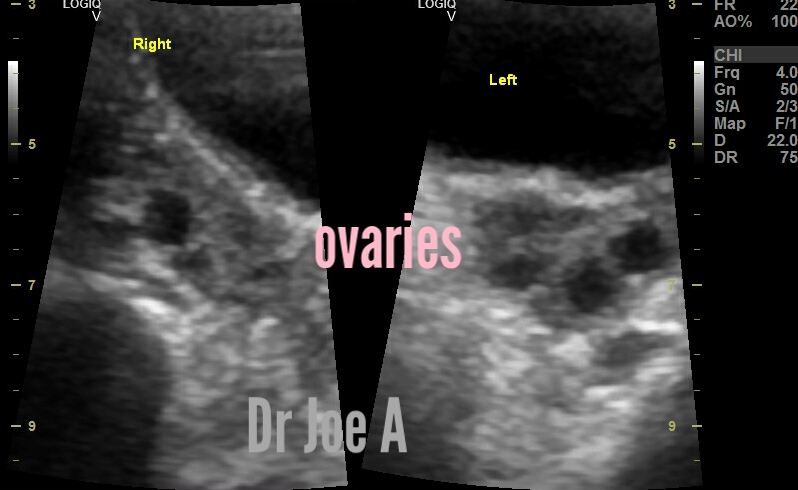ultrasound findings:
for PCOD in this 30-year-old female with ovaries of 11 cc volume each include:
The Rotterdam consensus defined the polycystic ovary as having 12 or more follicles, measuring between 2 and 9 mm (FNPO), and/or an ovarian volume (OV) >10 cm.
Ovary size and volume is frequently determined with ultrasound. The normal, adult, non-pregnant, mean ovary volume of women who are not postmenopausal is 6-7 mL.
Thus this patient has an ovarian volume of 11 cc each.
Final diagnosis: PCOD
Management:
Management advice in such a case includes:
- Ensuring proper weight management. Even a 5% reduction in weight can help a lot in treating the disease. Thus, PCOD patients must exercise on a regular basis and maintain a healthy diet¹.
- An ultrasound can check the appearance of your ovaries and the thickness of the lining of your uterus. If you have a diagnosis of PCOS, your provider might recommend more tests for complications.
Diet advisable in this lady is:
A healthful PCOD diet can include natural, unprocessed foods high-fiber foods fatty fish, including salmon, tuna, sardines, and mackerel kale, spinach, and other dark leafy greens¹. Women suffering from PCOD/PCOS are insulin resistant. Hence they should follow a diabetic diet. Their diet should be rich in fiber and low in carbs and processed foods.
In general people on a PCOS diet should avoid foods already widely seen as unhealthful. These include refined carbohydrates such as mass-produced pastries and white bread fried foods such as fast food fries margarine red or processed meats.
PCOS vs PCOD:
PCOD (Polycystic Ovarian Disease) and PCOS (Polycystic Ovary Syndrome) are two different conditions that affect ovaries in women during childbearing years. Here are some key differences between them:
- The primary difference between PCOD and PCOS is that PCOS is a more severe condition than PCOD.
- PCOD is a structural change in the ovaries which show multiple unhealthy or abnormal small cysts. Hence the term polycystic ovary.
Such women may have little/ few or no symptoms as compared to PCOS where multiple symptoms are present.
- When it comes to symptoms, there are many overlaps between them. However, a key differentiator is that PCOD symptoms rarely show up at an early age. They are typically visible only later in life. On the other hand, PCOS symptoms show up early, usually during teenage years.
- Also, the incidence of PCOD is far more than PCOS. UNICEF study suggests:
9 % of women have PCOS in India whilst 22% of women have PCOD.
For more on this visit:






No comments:
Post a Comment